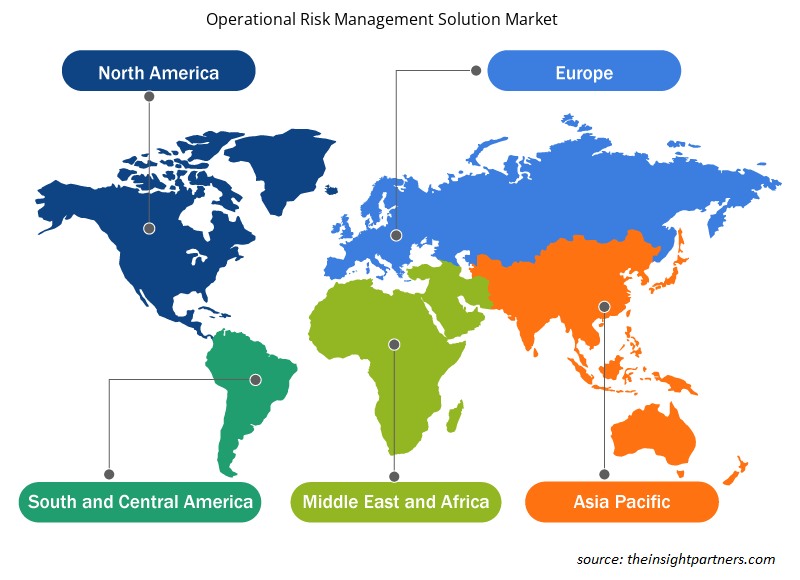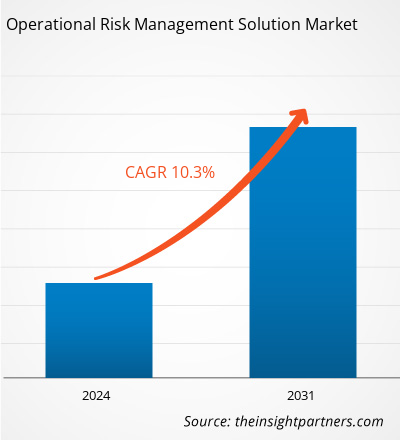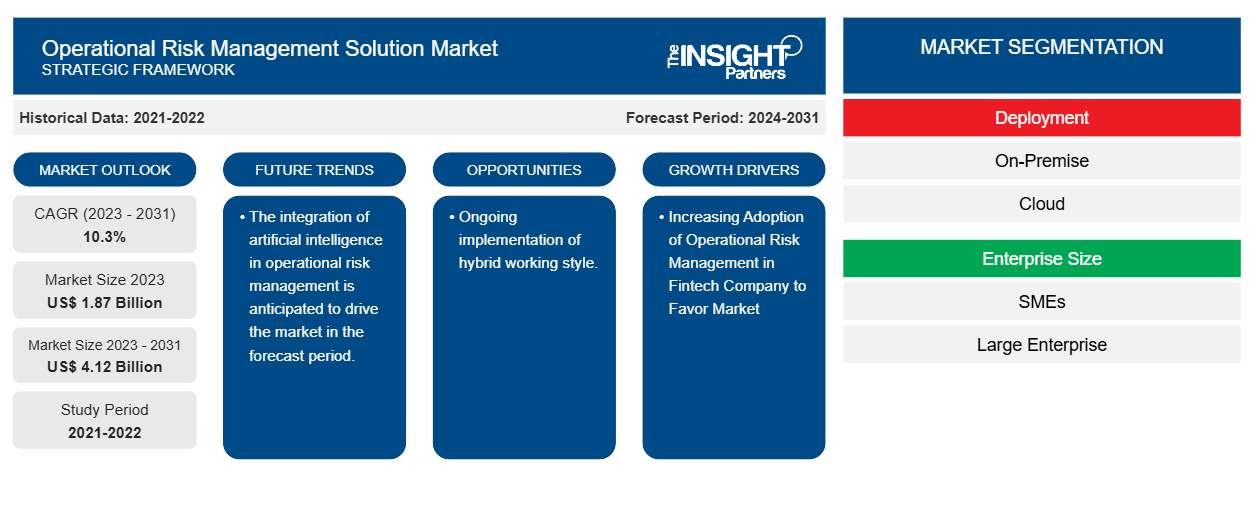运营风险管理解决方案市场规模预计将从 2023 年的 18.7 亿美元增至 2031 年的 41.2 亿美元。预计 2023-2031 年期间,该市场的复合年增长率将达到 10.3%。金融科技公司越来越多地采用运营风险管理,以及各种组织中网络攻击事件的增加,可能是运营风险管理解决方案市场的主要驱动因素和趋势。
运营风险管理解决方案市场分析
全球范围内,运营风险管理市场正在经历显著增长。这种增长归因于金融科技公司越来越多地采用运营风险管理,以及各种组织中网络攻击事件的增加。此外,混合工作方式的持续实施和人工智能在运营风险管理中的整合预计将在未来几年为运营风险管理市场带来重大机遇。
运营风险管理解决方案市场概况
运营风险管理 (ORM) 是一个涵盖风险评估、决策和风险控制执行的过程,旨在将此类威胁降低到适当的水平。针对所有部门和行业的运营风险管理,包括银行和金融服务的运营风险,将与制造工厂的运营风险有所不同。最终,任何组织都需要强大的运营风险管理流程,以避免潜在的灾难性问题并保证业务连续性。
定制此报告以满足您的需求
您可以免费定制任何报告,包括本报告的部分内容、国家级分析、Excel 数据包,以及为初创企业和大学提供优惠和折扣
-
获取此报告的关键市场趋势。这个免费样品将包括数据分析,从市场趋势到估计和预测。
运营风险管理解决方案市场驱动因素和机遇
金融科技公司越来越多地采用运营风险管理以利于市场
金融科技公司越来越多地采用运营风险管理确实推动了市场的发展。金融技术和行业正在快速扩张,行业中的公司数量也在快速增长。金融科技公司面临严格的监管需求。随着公司数量的增长,对合规和监管的需求也在增加。此外,金融科技公司包含各种包含敏感信息的财务数据,这些数据不能被泄露。这里的运营风险管理解决方案有助于防止金融科技公司的数据泄露。因此,考虑到上述参数,金融科技公司越来越多地采用运营风险管理正在推动运营风险管理解决方案市场的增长。
正在持续推行混合工作方式。
混合工作方式的持续实施预计将为市场带来许多机会。混合工作环境依赖于复杂的基础设施,需要强大的 IT 基础设施来管理远程工作的员工和办公室工作的员工。此外,网络犯罪的复杂性不断增加,采用混合工作模式的企业必须保持警惕,对数据安全进行强有力的控制。混合工作模式存在网络安全标准放松、员工保留等风险。运营风险管理解决方案可以预防这些风险。因此,考虑到上述参数,混合工作方式的持续实施预计将为市场带来许多机会。
运营风险管理解决方案市场报告细分分析
有助于得出运营风险管理解决方案市场分析的关键部分是部署和企业规模。
- 根据部署方式,运营风险管理解决方案市场分为本地部署和云部署。预计本地部署部分将在预测期内占据相当大的市场份额。
- 根据企业规模,运营风险管理解决方案市场分为中小企业和大型企业。预计中小企业在预测期内将占据相当大的市场份额。
运营风险管理解决方案市场份额(按地区)分析
运营风险管理解决方案市场报告的地理范围主要分为五个地区:北美、亚太、欧洲、中东和非洲、南美和中美。
北美在运营风险管理解决方案市场中占据主导地位。北美市场分为美国、加拿大和墨西哥。市场在各地区都经历了显著增长。这种增长归因于该地区日益增加的混合工作环境。北美地区各行业的高科技采用趋势推动了运营风险管理解决方案市场的增长。数字工具的采用率提高和政府机构的高技术支出等因素预计将推动北美运营风险管理解决方案市场的增长。
此外,美国和加拿大等发达经济体高度重视研发,这迫使北美企业将技术先进的解决方案引入市场。此外,美国拥有大量运营风险管理解决方案市场参与者,他们越来越专注于开发创新解决方案。所有这些因素都促进了该地区运营风险管理解决方案市场的增长。
运营风险管理解决方案市场区域洞察
Insight Partners 的分析师已详细解释了预测期内影响运营风险管理解决方案市场的区域趋势和因素。本节还讨论了北美、欧洲、亚太地区、中东和非洲以及南美和中美洲的运营风险管理解决方案市场细分和地理位置。

- 获取运营风险管理解决方案市场的区域特定数据
运营风险管理解决方案市场报告范围
| 报告属性 | 细节 |
|---|---|
| 2023 年的市场规模 | 18.7亿美元 |
| 2031 年市场规模 | 41.2亿美元 |
| 全球复合年增长率(2023 - 2031) | 10.3% |
| 史料 | 2021-2022 |
| 预测期 | 2024-2031 |
| 涵盖的领域 |
按部署
|
| 覆盖地区和国家 |
北美
|
| 市场领导者和主要公司简介 |
|
运营风险管理解决方案市场参与者密度:了解其对业务动态的影响
运营风险管理解决方案市场正在快速增长,这得益于最终用户需求的不断增长,而这些需求又源于消费者偏好的不断变化、技术进步以及对产品优势的认识不断提高等因素。随着需求的增加,企业正在扩大其产品范围,进行创新以满足消费者的需求,并利用新兴趋势,从而进一步推动市场增长。
市场参与者密度是指在特定市场或行业内运营的企业或公司的分布情况。它表明在给定市场空间中,相对于其规模或总市场价值,有多少竞争对手(市场参与者)存在。
在运营风险管理解决方案市场运营的主要公司有:
- Adapt IT 控股有限公司
- MetricStream
- RSA 安全
- TPSCO有限责任公司
- 思爱普
- 壳牌国际有限公司
免责声明:上面列出的公司没有按照任何特定顺序排列。

- 获取运营风险管理解决方案市场顶级关键参与者概述
运营风险管理解决方案市场新闻和最新发展
运营风险管理解决方案市场通过收集一手和二手研究后的定性和定量数据进行评估,其中包括重要的公司出版物、协会数据和数据库。以下列出了运营风险管理解决方案市场的一些发展情况:
- 澳大利亚审慎监管局(APRA)宣布最终确定审慎标准 CPS 230 运营风险管理(CPS 230)。据 APRA 称,CPS 230 旨在增强受 APRA 监管实体管理运营风险和应对业务中断的能力。(来源:APRA 公司网站,2023 年 7 月)
- 塔塔咨询服务公司 (TCS) 推出了一款敏捷且直观的基于风险的临床试验监控解决方案,可实现智能决策、提高合规性并提高研究效率。(来源:TCS 公司网站,2022 年 4 月)
运营风险管理解决方案市场报告范围和交付成果
“运营风险管理解决方案市场规模和预测(2021-2031)”报告对市场进行了详细分析,涵盖以下领域:
- 范围内涵盖的所有主要细分市场的全球、区域和国家层面的运营风险管理解决方案市场规模和预测
- 运营风险管理解决方案市场趋势以及市场动态,如驱动因素、限制因素和关键机遇
- 详细的 PEST/波特五力分析和 SWOT 分析
- 运营风险管理解决方案市场分析涵盖主要市场趋势、全球和区域框架、主要参与者、法规和最新市场发展
- 行业格局和竞争分析,涵盖市场集中度、热图分析、知名参与者以及运营风险管理解决方案市场的最新发展
- 详细的公司简介
- 历史分析(2 年)、基准年、预测(7 年)及复合年增长率
- PEST和SWOT分析
- 市场规模、价值/数量 - 全球、区域、国家
- 行业和竞争格局
- Excel 数据集
近期报告
相关报告
客户评价
购买理由
- 明智的决策
- 了解市场动态
- 竞争分析
- 客户洞察
- 市场预测
- 风险规避
- 战略规划
- 投资论证
- 识别新兴市场
- 优化营销策略
- 提升运营效率
- 顺应监管趋势























 获取免费样品 - 操作风险管理解决方案市场
获取免费样品 - 操作风险管理解决方案市场